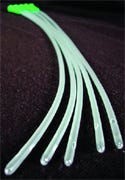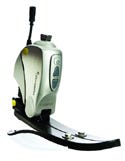April 8, 2007
Originally Published MPMN April 2007
OUTSOURCING OUTLOOK
Surface Treatment
Parylene Medical Coating Outsourcing Considerations
|
Paul DeMattie, Manager, Middletown, CT, Coating Center, Para Tech Coatings Inc., headquartered in Aliso Viejo, CA. |
Parylene coating has been used in medical component and device manufacturing for more than 20 years. This very thin film has advantageous dielectric properties and resists biofluids, moisture, chemicals, organic solvents, acids and reagents. Parylene features include electrical insulation, moisture and chemical isolation, mechanical protection, enhanced lubricity, and surface consolidation. Properly applied, vacuum-deposited parylene withstands autoclaving, radiation, and ethylene oxide sterilization. This high-performance medical coating is generally applied by qualified outsource suppliers, which allows medical component and device manufacturers to avoid the overhead of a sophisticated coating operation requiring coating systems, production floor space, energy cost, staffing, training, and administration. It is important to select an outsource parylene coating supplier that has the requisite technical expertise, medical application experience, and production resources to deliver cost-effective coating services from application engineering through delivery of coated parts. For example, a medical coating service supplier should:
Maintain FDA Device and Drug Master Files with comprehensive ISO 10993 biological evaluation data to assist customers in meeting FDA premarket documentation requirements.
Meet stringent medical manufacturing quality standards and satisfy USP Class IV biological testing requirements.
Have a stable, full-time, adequately trained, and dedicated workforce, and the relationship should be protected by nondisclosure and confidentiality agreements.
Have demonstrated experience in medical coating applications, cutting-edge production technology resources, and established production, process control and quality management procedures.
Nanosurface Fluoropolymer Coating Services Improve Surface Properties
|
A processing service resolves many of the problems that occur in precision assemblies, probes, sensors, micron-sized nozzles and orifices, and MEMS. Fluoropolymer NS is plasma-bonded onto the surface using ultra-high-vacuum processing, performed at room temperature. The customized precison vapor-deposition process provides a nanostructured coating with extremely tight tolerances without clogging or bridging, with no damage to the substrate. Improvements in surface properties are the result of the process, according to the company, including low surface energy; improved friction and wear; and reduced sticking, seizing, and stiction; as well as improved surface release and liquid-dispensing capabilities. Supercritical tolerances in thin fluoropolymer layers are available for a variety of device designs.
Surface Engineering Associates, Eldersburg, MD
www.seac1.com
Proprietary Processes Result in Improved Results, Faster Turnaround
A company’s parylene coating systems use a proprietary deposition sequence that is based on time and temperature alone and does not depend on chamber pressure fluctuations related to the flow of monomer gas. This advanced process-control methodology has been refined over more than 30 years of operation, and is reportedly not available from any other Parylene coating supplier.
The company provides application engineering support for every project, with engineering runs typically completed according to the customer’s schedule. Production is accomplished using large automated static coating systems for fixtured parts, and tumble-coat deposition equipment for high quantity, uniform parts that lend themselves to this type of coating.
The company is certified to the standards of ISO 2002, IPC Standard 830, and MIL-I-46058C.
Para Tech Coating Inc., Aliso Viejo, CA
www.parylene.com
Hydrophilic Technology Is Slippery When Wet
|
A patented water-based hydrophilic coating technology overcomes many of the physical and processing limitations of current hydrophilic coatings, according to the company. The process produces an interpenetrating-network type of lubricious coating that is slippery when wet. The coating consists of a chemically crosslinked supporting polymer network with long-chain hydrophilic molecules intertwined with it. The coatings are lubricious, aqueous, durable, biocompatible, and flexible. Applications include urology, cardiology, neurology, and diagnostics. The coatings can be modified to exhibit properties such as antimicrobial and hemocompatible characteristics.
AST Products Inc., Billerica, MA
www.astp.com
Metal Finisher Offers Precision Services
A firm offers services such as anodizing, Teflon impregnation of hard anodize, passivation of stainless steel, chemical films, anofaxing, silk-screening, laser marking and laser engraving, a two-step electrolytic process for fade resistance that is compatible with the Sterrad sterilization system, and precision masking. The company offers more than 30,000 sq ft of production area and has installed an ion-exchange system, allowing complete water recycling capabilities.
K & L Anodizing Corp., Burbank, CA
www.klanodizing.com
Reliable, Consistent Temperature Is Critical to Parylene Coatings
A company’s parylene deposition systems use a Windows XP–based computer control system featuring user-configurable parameters and a flat-panel display. Operating temperatures and pressures are continuously monitored and recorded. The deposition system must be kept precisely at a temperature of 680°C, with no variation. The coatings are applied to a variety of surfaces. Polymer deposition takes place at the molecular level as parylene dimer is vaporized under vacuum and heated to form a dimeric gas, then pyrolized to cleave the dimer to its monomeric form, and finally deposited as a transparent polymer film. The firm has nine coatings centers worldwide and in addition to providing its services, offers the equipment to its customers.
Specialty Coating Systems, Indianapolis, IN
www.scscoatings.com
Bore Finishing Aids in Manufacturing New Prosthetic Foot
|
One of the key aspects of a new prosthetic foot is the extremely close-tolerance fit between the pins and the two bronze bushes that pivot the ankle. In order for the foot to function correctly, these elements must move smoothly together, creating neither friction nor play. This is a difficult challenge for assembled production items. A provider of bore-finishing services came up with a solution that did not require the use of a specialized finishing machine. The bushes are manufactured from a material on which it is difficult to achieve a good surface finish due to its softness, which can lead to clogging of the diamond material on the tool. The firm used bore-finishing mandrels and diamond sleeves with a large diamond grit size and preconditioned the tooling. This reduces the amount of adjustment necessary in the early life of the tool. The company makes superabrasive finishing systems for surface polishing and close-tolerance requirements. Services include diamond flat lapping and polishing, and R&D and support.
Engis Ltd., Henley-on-Thames, Oxon, UK
www.engis.com
Copyright ©2007 Medical Product Manufacturing News
You May Also Like






